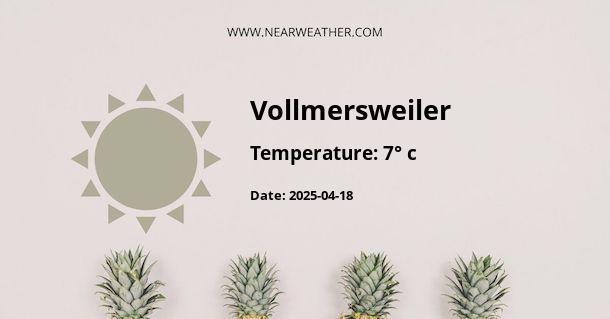Vollmersweiler, Germany: Climate and Weather Year Round
Vollmersweiler is a picturesque village located in the southern part of Germany, specifically in the state of Rhineland-Palatinate. With its charming scenery and rich cultural heritage, Vollmersweiler attracts tourists and nature enthusiasts alike. One important aspect that visitors often consider when planning a trip to this region is the climate and weather conditions throughout the year. In this article, we will explore the climate of Vollmersweiler and provide detailed information about the weather patterns experienced in this area.
Geographical Location and Topography
Vollmersweiler is situated on the eastern slopes of the Palatinate Forest, which is part of the larger German Central Uplands. This location has a significant impact on the climate of the region. The village is nestled in a valley, sheltered from strong winds and extreme weather conditions. The surrounding hills and forests contribute to a microclimate that is characterized by mild temperatures and a relatively high amount of precipitation.
Temperature
The temperature in Vollmersweiler varies throughout the year, with distinct seasons. Summers are generally warm and pleasant, with temperatures ranging from 20°C (68°F) to 25°C (77°F). The warmest months are July and August, when temperatures can occasionally reach up to 30°C (86°F). Winters are cold but not excessively harsh, with average temperatures ranging from 0°C (32°F) to 5°C (41°F). The coldest months are January and February, with temperatures occasionally dropping below freezing.
It is important to note that Vollmersweiler, like many other regions in Germany, experiences a significant temperature variation between day and night throughout the year. This diurnal temperature range can be as high as 10°C (18°F) in the summer and 15°C (27°F) in the winter.
Precipitation
Vollmersweiler receives a moderate amount of precipitation throughout the year, making it a relatively humid area. The annual average rainfall is around 800-900 millimeters (31-35 inches). Rainfall is evenly distributed across the seasons, with slightly more precipitation occurring during the summer months. July and August are the wettest months, with an average of 80-100 millimeters (3-4 inches) of rainfall. The drier months are typically December and January, with an average of 40-50 millimeters (1.6-2 inches) of rainfall.
The region also experiences a fair amount of snowfall during the winter months. Snow is not uncommon, especially in January and February, with an average of 5-10 snowy days per month. The snow cover usually lasts for a few days before melting away.
Sunshine Hours
Vollmersweiler enjoys a decent amount of sunshine throughout the year. The village experiences an average of 1,800-2,000 hours of sunshine annually. The sunniest months are generally May to August, with an average of 6-8 hours of sunshine per day. The winter months, particularly November to January, have the least amount of sunshine, with an average of 2-3 hours per day.
Wind
Due to its location in the sheltered valley of the Palatinate Forest, Vollmersweiler is not prone to strong winds. The surrounding hills and forests act as natural barriers, reducing the impact of wind on the village. The prevailing winds in the area are gentle, predominantly coming from the west and southwest.
Climate Summary
The climate of Vollmersweiler can be classified as a temperate oceanic climate, characterized by mild summers and relatively mild winters. The village experiences a moderate amount of rainfall throughout the year, with no distinct dry season. The temperature variation between day and night is significant, adding to the overall weather patterns of the region.
Best Time to Visit Vollmersweiler
The best time to visit Vollmersweiler depends on personal preferences and the type of activities one intends to engage in. Summer, from June to September, is an excellent time to explore the beautiful hiking trails and enjoy outdoor activities in the surrounding forests. The weather is warm, and the days are longer, allowing for more outdoor adventures.
For those who prefer milder temperatures and fewer crowds, spring (March to May) and autumn (September to November) are ideal. The scenery during these seasons is breathtaking, with vibrant colors and a tranquil atmosphere. It is important to note that the weather can be more unpredictable during these transitional seasons, so it is advisable to pack layers and be prepared for changing conditions.
Winter, from December to February, offers a different charm with the possibility of snowfall. The village becomes a winter wonderland, and visitors can enjoy activities such as skiing, snowboarding, and cozy evenings by the fireplace. However, it is essential to check the weather conditions and road accessibility during this time, as snowfall can affect transportation.
Conclusion
Vollmersweiler, Germany, experiences a temperate oceanic climate with mild summers and relatively mild winters. The village is located in a valley, sheltered by the Palatinate Forest, which contributes to its unique microclimate. The region receives a moderate amount of precipitation throughout the year, with no distinct dry season. The temperature variation between day and night is significant, and Vollmersweiler enjoys a decent amount of sunshine annually. Whether visiting in summer, spring, autumn, or winter, Vollmersweiler offers a diverse range of activities and breathtaking scenery for visitors to enjoy.
A - Vollmersweiler's Latitude is 49.064999 & Longitude is 8.077220.
A - Weather in Vollmersweiler is 14° today.
A - Climate Conditions in Vollmersweiler shows moderate rain today.
A - Humidity in Vollmersweiler is 87% today.
A - Wind speed in Vollmersweiler is 3.2 km/h, flowing at 147° wind direction. today.
